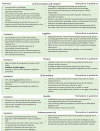Barriers and Facilitators for Implementing Paediatric Telemedicine: Rapid Review of User Perspectives
- PMID: 33816401
- PMCID: PMC8010687
- DOI: 10.3389/fped.2021.630365
Barriers and Facilitators for Implementing Paediatric Telemedicine: Rapid Review of User Perspectives
Abstract
Background: COVID-19 has brought to the fore an urgent need for secure information and communication technology (ICT) supported healthcare delivery, as the pertinence of infection control and social distancing continues. Telemedicine for paediatric care warrants special consideration around logistics, consent and assent, child welfare and communication that may differ to adult services. There is no systematic evidence synthesis available that outlines the implementation issues for incorporating telemedicine to paediatric services generally, or how users perceive these issues. Methods: We conducted a rapid mixed-methods evidence synthesis to identify barriers, facilitators, and documented stakeholder experiences of implementing paediatric telemedicine, to inform the pandemic response. A systematic search was undertaken by a research librarian in MEDLINE for relevant studies. All identified records were blind double-screened by two reviewers. Implementation-related data were extracted, and studies quality appraised using the Mixed-Methods Appraisal Tool. Qualitative findings were analysed thematically and then mapped to the Consolidated Framework for Implementation Research. Quantitative findings about barriers and facilitators for implementation were narratively synthesised. Results: We identified 27 eligible studies (19 quantitative; 5 mixed-methods, 3 qualitative). Important challenges highlighted from the perspective of the healthcare providers included issues with ICT proficiency, lack of confidence in the quality/reliability of the technology, connectivity issues, concerns around legal issues, increased administrative burden and/or fear of inability to conduct thorough examinations with reliance on subjective descriptions. Facilitators included clear dissemination of the aims of ICT services, involvement of staff throughout planning and implementation, sufficient training, and cultivation of telemedicine champions. Families often expressed preference for in-person visits but those who had tried tele-consultations, lived far from clinics, or perceived increased convenience with technology considered telemedicine more favourably. Concerns from parents included the responsibility of describing their child's condition in the absence of an in-person examination. Discussion: Healthcare providers and families who have experienced tele-consultations generally report high satisfaction and usability for such services. The use of ICT to facilitate paediatric healthcare consultations is feasible for certain clinical encounters and can work well with appropriate planning and quality facilities in place.
Keywords: digital health; e-health; implementation; paediatrics; telehealth; telemedicine.
Copyright © 2021 Tully, Case, Arthurs, Sorensen, Marcin and O'Malley.
Conflict of interest statement
The authors declare that the research was conducted in the absence of any commercial or financial relationships that could be construed as a potential conflict of interest.
Figures
Similar articles
-
Healthcare stakeholders' perceptions and experiences of factors affecting the implementation of critical care telemedicine (CCT): qualitative evidence synthesis.Cochrane Database Syst Rev. 2021 Feb 18;2(2):CD012876. doi: 10.1002/14651858.CD012876.pub2. Cochrane Database Syst Rev. 2021. PMID: 33599282 Free PMC article.
-
Challenges, Barriers, and Facilitators in Telemedicine Implementation in India: A Scoping Review.Cureus. 2024 Aug 21;16(8):e67388. doi: 10.7759/cureus.67388. eCollection 2024 Aug. Cureus. 2024. PMID: 39310647 Free PMC article.
-
Perceived barriers and facilitators to the adoption of telemedicine infectious diseases consultations in southeastern Missouri hospitals.J Telemed Telecare. 2024 Oct;30(9):1462-1474. doi: 10.1177/1357633X221149461. Epub 2023 Jan 19. J Telemed Telecare. 2024. PMID: 36659820 Free PMC article.
-
Implementation barriers and facilitators of remote monitoring, remote consultation and digital care platforms through the eyes of healthcare professionals: a review of reviews.BMJ Open. 2024 Jun 10;14(6):e075833. doi: 10.1136/bmjopen-2023-075833. BMJ Open. 2024. PMID: 38858155 Free PMC article.
-
Facilitators and barriers to the transition from outpatient clinic visits to home-based check-ups for children being treated with growth hormone: a mixed-methods study.Eur J Pediatr. 2024 Apr;183(4):1857-1870. doi: 10.1007/s00431-023-05408-z. Epub 2024 Jan 31. Eur J Pediatr. 2024. PMID: 38294515 Free PMC article.
Cited by
-
Touching Technology-Parents' Experiences of Remote Consultations for Children With Severe Congenital Cardiac Conditions: Quasi-Experimental Cohort Study.JMIR Pediatr Parent. 2024 Oct 22;7:e54598. doi: 10.2196/54598. JMIR Pediatr Parent. 2024. PMID: 39437148 Free PMC article.
-
Informed Consent in Paediatric Telemedicine: Challenge or Opportunity? A Scoping Review.Healthcare (Basel). 2023 May 15;11(10):1430. doi: 10.3390/healthcare11101430. Healthcare (Basel). 2023. PMID: 37239716 Free PMC article.
-
eHealth usage among parents to premature or surgically treated neonates: associations with eHealth literacy, healthcare satisfaction or satisfaction with an eHealth device.BMC Pediatr. 2023 Oct 21;23(1):524. doi: 10.1186/s12887-023-04340-3. BMC Pediatr. 2023. PMID: 37865736 Free PMC article.
-
Assessment of Trends in Non-Restorative and Preventative Dental Treatment Pre- and Post-COVID-19: A Health Informatics Pilot Study.Children (Basel). 2025 Mar 14;12(3):357. doi: 10.3390/children12030357. Children (Basel). 2025. PMID: 40150641 Free PMC article.
-
Translating primary care to telehealth: analysis of in-person paediatric consultations and role of carers.BJGP Open. 2025 Apr 24;9(1):BJGPO.2024.0030. doi: 10.3399/BJGPO.2024.0030. Print 2025 Apr. BJGP Open. 2025. PMID: 39486835 Free PMC article.
References
-
- Eccleston C, Blyth FM, Dear BF, Fisher EA, Keefe FJ, Lynch ME, et al. . Managing patients with chronic pain during the COVID-19 outbreak: considerations for the rapid introduction of remotely supported (eHealth) pain management services. Pain. (2020) 161:889–93. 10.1097/j.pain.0000000000001885 - DOI - PMC - PubMed
-
- Center for Disease Control and Prevention . Healthcare Facilities: Managing Operations During the COVID-19 Pandemic 2020. Available online at: https://www.cdc.gov/coronavirus/2019-ncov/hcp/guidance-hcf.html (accessed June 28, 2020).
Publication types
LinkOut - more resources
Full Text Sources
Other Literature Sources



